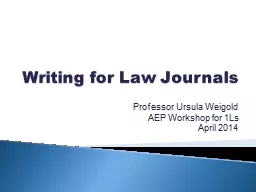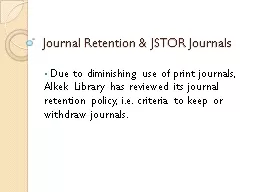PPT-Writing for Law Journals
Author : conchita-marotz | Published Date : 2017-06-30
Professor Ursula Weigold AEP Workshop for 1Ls April 2014 Introduction Background Analysis Conclusion The traditional case note I Have a clear viewpoint or thesis
Presentation Embed Code
Download Presentation
Download Presentation The PPT/PDF document "Writing for Law Journals" is the property of its rightful owner. Permission is granted to download and print the materials on this website for personal, non-commercial use only, and to display it on your personal computer provided you do not modify the materials and that you retain all copyright notices contained in the materials. By downloading content from our website, you accept the terms of this agreement.
Writing for Law Journals: Transcript
Download Rules Of Document
"Writing for Law Journals"The content belongs to its owner. You may download and print it for personal use, without modification, and keep all copyright notices. By downloading, you agree to these terms.
Related Documents







![[DOWNLOAD] - 180 Days of Writing for Third Grade - An Easy-to-Use Third Grade Writing](https://thumbs.docslides.com/901429/download-180-days-of-writing-for-third-grade-an-easy-to-use-third-grade-writing-workbook-to-practice-and-improve-writing-skills.jpg)
![[DOWNLOAD] - 180 Days of Writing for Kindergarten - An Easy-to-Use Kindergarten Writing](https://thumbs.docslides.com/901444/download-180-days-of-writing-for-kindergarten-an-easy-to-use-kindergarten-writing-workbook-to-practice-and-improve-writing-skills.jpg)
![[EBOOK] - 180 Days of Writing for First Grade - An Easy-to-Use First Grade Writing Workbook](https://thumbs.docslides.com/901798/ebook-180-days-of-writing-for-first-grade-an-easy-to-use-first-grade-writing-workbook-to-practice-and-improve-writing-skills.jpg)
![[READ] - Law School Buzz Book: Law School Students and Alumni Report on More than 100](https://thumbs.docslides.com/902498/read-law-school-buzz-book-law-school-students-and-alumni-report-on-more-than-100-top-law-schools-vault-career-library.jpg)



